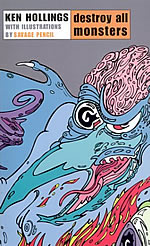Savage Pencil:
The Bite Of The Pencil
In the same way that R. Crumb’s comix captured the hippy experience of Sixties America, Savage Pencil’s cartoon outpourings embodied the punk rock spirit of Britain in the late Seventies. Ever since, his comix and music journalism, bands and performances, record and book covers, have confirmed ‘Sav’ as a true renaissance monster.
In the early Sixties, America’s exotic pulp culture sailed over to the provinces in Britain as bales of cheap, sometimes water-sodden ships’ ballast. Haphazard bundles of comic books, men’s magazines, trashy paperbacks, flotsam tied up with string, landed each month on local newsagents’ counters. Like the corner shop in Leeds run by young Edwin Pouncey’s parents. What better place to grow up for a voracious, visually-stimulated kid? Sometimes, when Edwin was helping out, his Dad would let him cut the string and cream off the best Marvels and DCs, rarities like a copy of Harvey Kurtzman’s Help!, or paperback reprints of EC’s Tales From The Crypt and Mad. Edwin swam in this transatlantic tide of newsprint treasures. For this innocent seduced, studying under the bedclothes and scribbling away at comics of his own, the early education of a cartoonist was underway.
By 1969, he had immersed himself in Zappa, Beefheart, Mothers of Invention and whatever great music he could find and he had glimpsed a few reprints of strips in British rags like Oz and I.T., but psychedelic San Francisco was a long way from grey, gloomy Leeds. As luck would have it, he managed to hoodwink his mother into ordering him a special issue he had spotted of the highbrow journal Art And Artists. This glossy revue would be his first tantalising taste of the West Coast’s underground comix movement in full flower. Its pioneers - Robert Crumb, Rick Griffin, Victor Moscoso, S. Clay Wilson, and others - had grabbed the medium out of the clutches of the stultifying regulators and sheepish money-makers and reinvigorated it as the perfect accessible vehicle to disseminate a storytelling artist’s most unfettered imaginings.
Edwin’s visits to London from Essex - where he had moved in 1971 - opened up that world as never before. On his first trip to Soho’s trippy bazaar Dark They Were And Golden Eyed, he finally got his trembling hands on the real things. Those copies of early Zap Comix and other mythic titles rekindled in him the undeniable calling to become an underground cartoonist himself. Pursuing this by entering art school in London, his exploration into visionary artists from the past - William Blake, Austin Osman Spare, George Grosz to name three - deepened the inspirational mulch which would feed his own creative endeavours.
Punk was barely born by the time the mysterious ‘Savage Pencil’ first soiled the pages of the weekly music paper Sounds. While at the Royal College of Art in 1976, Edwin had been going every week to the dingy jazz joint The 100 Club on Oxford Street to see the Sex Pistols perform. They were still in their fierce embryonic state before the press got hold of them, playing to a handful of apathetic punters.
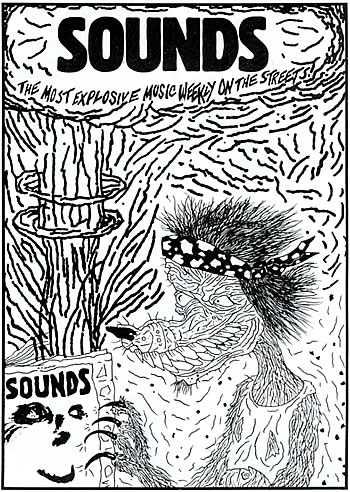
Edwin, however, responded to the energy there on stage. It was something he’d experienced before, when he was absorbed in his comix and listening to records, but this was suddenly more real. He was face-to-face with it, looking down the maw at the real thing. Stranded in Leeds, he’d missed out on London’s Sixties hippy experience. What excited him now was that he was witnessing a different animal, punk, emerging in London and this time he could take part. If he could store up some of that energy inside, take it home with him and try letting it loose on a piece of paper, what might come out? Back one night after hearing the Pistols, he began slashing out at the paper, almost wounding it with his pen, pouring out feral scrawlings that seemed to convulse with frustration and rage. Looking anew, there on the page he had unleashed the ‘Savage Pencil’, the visual incarnation of punk rock.
Early in 1977, on the suggestion of his friend Vivienne Goldman, Edwin showed some of these Savage Pencil toons to Alan Lewis at Sounds. As editor he instantly spotted their sublimely crude urgency, all the more arresting for appearing amateurish, like the rush of pumping out a fanzine. Lewis was all set to turn the paper away from rock relics like Clapton and Yes and extol the nascent punk revolution. He insisted on printing all of Edwin’s mad creatures on a big page and made up a title for them: "How about… Rock’n'Roll... Zoo!?". If they’d had a volume control, they would have been ear-splittingly loud on the page.
So it began and week after week, a pooch-like personification of Savage Pencil, often in an artist’s beret, would lurch around this Zoo, reporting from its assorted cages and the incredible variety of animal species they contained. As well as being deviously funny, his comix became the perfect weapon with which to make scathing commentary on the idiocies of the music industry. The more Sav learned about it as a journalist on Sounds, the more merciless he became, riling up everyone, the punks included when he started covering bands he loved like The Grateful Dead and Todd Rundgren. As he saw it, "Why should music be attributable to just one genre? The whole thing is fantastic and all good music should be appreciated, no matter what it is or who is making it."
By the time he closed the gates on his Rock’n'Roll Zoo in 1981, Sav had twisted his knife into countless egos, from rock stars, top execs and deejays to hack journos, marketing gurus and groupies. If anything, his revival of the strip, in Tower Records’ mainstream monthly Top of all places, was even more venomous, because by then he had grown wiser and more hateful of how music was changing, with the welter of new Brit bands like Oasis and the Spice Girls just begging to be kicked, stabbed and punched. After Top folded, Sav trained his eagle eye and caustic wit on the experimental music scene, in Trip or Squeek currently running in The Wire. Here his strips have become more surreal and improvised, again as if they are the drawn equivalents of the music he is commenting on.
His surges of creating comics come in waves. Sav harbours a love-hate relationship for the medium, but somehow he always returns to it eventually. For example, in 1983, after two years without his Sounds strips, he felt compelled to scratch out the absurd, ultra-violent shenanigans of punk zombie Mr Inferno. Rather than redraw and polish them up, however, he published his raw sketches, blown up to look even more insane, in 500 copies of Corpsemeat Comix #1, ‘Nourishment for Diseased Minds’. His comeback coincided with a resurgence in British comix at the time, a real self-publishing movement nurtured by the Fast Fiction service and by Escape magazine, soon to be one of his regular outlets alongside Chris Long, Ed Pinsent, John Bagnall and others.
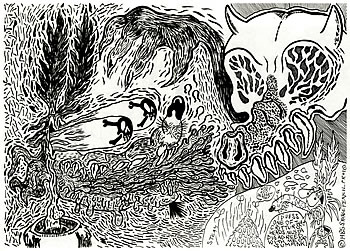
Out of this ferment grew Battle of the Eyes, almost a rock band of comix creators, where Sav was joined by Chris Long and Andy Johnson, brother of Matt from The The, on their brilliant one-and-only collaboration Nyak-Nyak in 1986. A stunning second Corpsemeat in 1989 saw Sav take on the difficult role of editor, gathering work by Gary Panter, Mark Beyer, Bruno Richard and more of his inky brethren in Britain, America and France and supervising two different editions, one a standard version printed in California, the other a deluxe giant gorgeously silk-screened in Paris. These things take time, but he is steadily gestating a third Corpsemeat for the coming year.
When he started at Sounds, comics were not his only contributions. As a staff member, Edwin Pouncey had to pursue the painful but rewarding challenge of writing about music. To him reviewing a record or gig means trying to share the experience and what effect it had on him personally, in the hope that some of that excitement would transfer to the reader and fire their interest. Over the past twenty five years and more of articles and interviews, he has had the chance to meet such greats as John Cale and Iggy Pop, most recently going backstage at a Stooges concert in Paris to see Ron Ashton. To this day, Edwin’s passion for seeking out the best in music to write about, wherever it comes from, and the hyperventilating thrill he feels whenever he meets one of his heroes, remain as strong as ever.
On top of his writing, his deep involvement with music takes other forms. As an artist, Savage Pencil has crafted unforgettable designs for Sonic Youth, Big Black, The Fall, Sunn O))) and many more, as well as a new series of uncanny ink collage portraits for The Wire. As a demented record collector he has gathered a number of remarkable tracks, notably on Angel Dust: Music for Movie Bikers (Blast First, 1988) and The Antiquack: A Dead Duck Selection (EMI, 1999). He sees these more as ‘compositions’ than compilations, where Duke Ellington can sit next to Quicksilver Messenger Service, or Faust flow into Sun Ra. As a deejay, he applies this same principle to his weekly Resonance FM broadcasts.
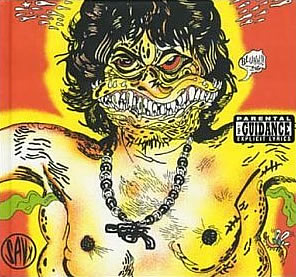
Edwin has also been making music of his own, in such bands as The Art Attacks, Tagmemics, Kray Cherubs, Satin Chickens and Attack Wave Pest Repeller. This summer he performed with Jay Cotton and Jonathan Rosen accompanying a new Light Show devised by Fillmore East legend Joshua White and Gary Panter at New York’s Anthology Film Archive. Their crazy freeform soundtrack was a mixture of their responses to each other and to the shifting images made by the oil wheels, light bulbs and smoke. Guitar is his favourite instrument, though he admits he doesn’t play it so much as make spontaneous noises out of it, coaxing, altering and suppressing them, as if he was drawing them in sound.
It all comes back to drawing. His latest artistic obsession is etching. "Everything is encompassed in it, the drawing aspect, slamming your pen directly into a lump of metal and working with acid and flame, so you get dirty and there’s an alchemical quality to it. Then there’s the aspect of printing your own piece of art. These etchings, or ‘itchings’ as I call mine, look and feel totally different from a comic, though they come from that tradition. Like a comic but without balloons."
What is inspiring is that the everyday Edwin Pouncey and the wildman Savage Pencil are not one and the same, nor some schizoid Jekyll-and-Hyde, but two personas living their creative double-life at full volume.
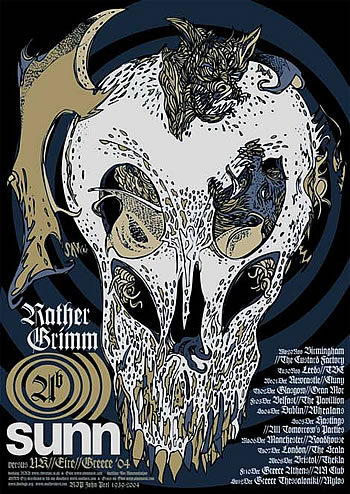
The original version of this article appeared in 2004 in the pages of Dazed & Confused, the modern guide to music, fashion, film, art and ideas.













